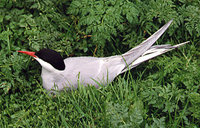Farne Islands
|
|
The Farne Islands (also referred to less formally as the Farnes) are a group of islands off the coast of Northumberland, England. There are between 15 to 20 or more islands depending on the state of the tide. They are scattered about 2.5-7.5 km (1½-4¾ miles) distant from the mainland, divided into two groups, the Inner Group and the Outer Group. The main islands in the Inner Group are Inner Farne, Knoxes Reef and the East and West Wideopens (all joined together on very low tides) and (somewhat separated) the Megstone; the main islands in the Outer Group are Staple Island, the Brownsman, North and South Wamses, Big Harcar and the Longstone. The two groups are separated by Staple Sound. The highest point, on Inner Farne, is 19m above mean sea level.
The islands have no permanent population, the only residents being National Trust bird wardens during part of the year: they live in the old pele tower on the Inner Farne, the largest and closest inshore of the islands, and the lighthouse cottage on the Brownsman in the outer group. The pele tower was built by or for Thomas Castell, Prior of Durham about 1500. There is also a chapel set up on the site of St Cuthbert's oratory 600 years ago. It was restored in recent times with old material all from Durham Cathedral. The first recorded visitor was Saint Aidan followed by Saint Cuthbert. The latter was called to the bishopric of Lindisfarne but after two years he returned to the solitude of the Inner Farne and died there in 687. Among other acts, St Cuthbert introduced special laws in 676 protecting the Eider ducks and other seabirds nesting on the islands; these are thought to be the earliest bird protection laws anywhere in the world.

All the lighthouses on the Farnes are now automatic and have no resident keepers, although in former years they did: the Grace Darling story originates from the Longstone lighthouse. Ruins of older lighthouses may be seen, for example on the Brownsman where there are two. Before the lighthouses there were beacons on several of the islands. The prominent white streak on the cliff facing the mainland (see photo) is often thought by visitors to be bird droppings: although many parts of the islands do exhibit this colouring, in this case it is the result of chalk deposits from the many years of spent calcium carbide from the lighthouse being thrown down the cliff.
Farne_Islands_puffin_in_burrow.jpg
In the warmer months the Farnes, an important wildlife habitat, are much visited by boat trips from Seahouses. Local boats are licensed to land passengers on Inner Farne, Staple Island and the Longstone; landing on other islands is prohibited to protect the wildlife. At the right time of year many Puffins can be seen and these are very popular with visitors; on the Inner Farne, the Arctic Terns nest close to the path and will attack visitors who come too close (visitors are strongly advised to wear hats!). Some of the islands also support a population of Rabbits, which were introduced as a source of meat and have since gone wild. The Rabbit and Puffin populations use the same burrows at different times, the Puffins being strong enough (a vicious bite!) to evict the Rabbits from the burrows during the nesting season. The islands also hold a notable colony of about 6,000 Grey Seals, with several hundred pups born every year in September-November.
Kitti.jpg
Breeding birds on the Farnes (as of 2003) include:
- Common Eider - 1,036 pairs
- Fulmar - 246 pairs
- Great Cormorant - 179 pairs
- Shag - 1,678 pairs
- Oystercatcher - 36 pairs
- Herring Gull - 414 pairs
- Lesser Black-backed Gull - 427 pairs
- Kittiwake - 5,192 pairs
- Sandwich Tern - 1,999 pairs
- Roseate Tern - 2 pairs in 2002 (endangered species)
- Common Tern - 76 pairs
- Arctic Tern - 1,727 pairs
- Guillemot - 42,338 pairs
- Razorbill - 222 pairs
- Puffin - 55,674 pairs
- Rock Pipit - 28 pairs
A total of 290 bird species have been recorded on the Farnes, including in about 1760, an example of the now-extinct Great Auk.
On 28-29 May 1979, an Aleutian Tern, a rare tern from the Aleutian Islands in the North Pacific Ocean, visited the Farnes. It was the first, and still the only, member of its species ever seen anywhere in Europe. It remains a complete mystery how it got here.
A longer-staying unusual visitor was "Elsie" the Lesser Crested Tern, who visited the Farnes every summer from 1984 to 1997; during that period, she (paired with a male Sandwich Tern) raised several hybrid chicks, and attracted several thousand birders keen to see this species in Britain. Lesser Crested Terns normally nest on islands off the coast of Libya and migrate to West Africa for the winter; it is thought that "Elsie" took a wrong turn - or should that be a wrong tern?! - at the Straits of Gibraltar on spring migration.
An Arctic Tern from the Farnes, ringed as a chick not yet old enough to fly in summer 1982, reached Melbourne, Australia in October 1982, a sea journey of over 22,000 km (14,000 miles) in just three months from fledging. This remains one of the longest distances travelled by any bird.
One classic view of the Farnes, very popular with photographers, is that from the harbour at Seahouses. However, they are closer to the mainland further up the road northwards towards Bamburgh and excellent views may be seen from here, in the vicinity of the Monks House Rocks, as well as from Bamburgh castle and beach.
See also
- Lindisfarne - nearby to the northwest
- Coquet Island - another important bird reserve island about 30 km south
- Bamburgh with Bamburgh Castle and Seahouses - nearest places on the coast
External links
- Farne Islands access & information (commercial) (http://www.farne-islands.com/information/)

